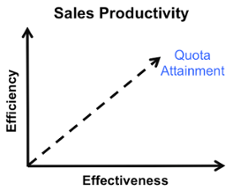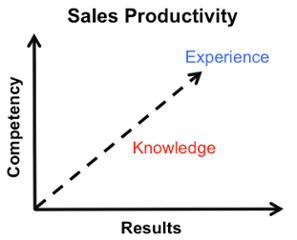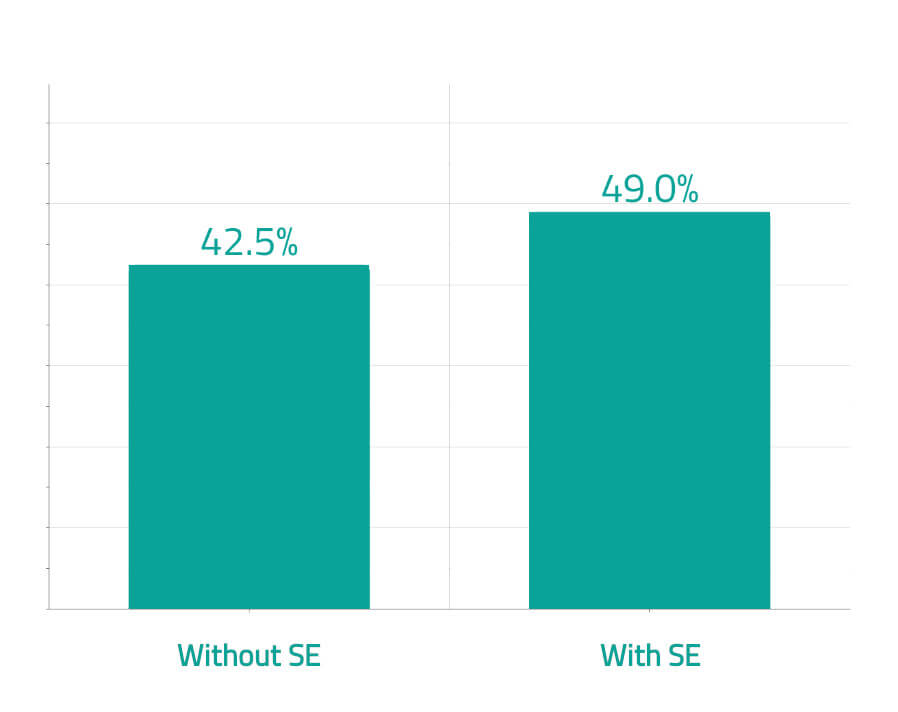In our conversations with CEOs and sales and marketing directors, we keep hearing the same comment – that fewer and fewer salespeople are meeting their targets. And further investigation has made the reason for this very clear: salespeople have insufficient knowledge of their customers and the market, and are lacking some of the specific competencies required in today’s marketplace.
Various research has shown that revenue and sales quotas are becoming increasingly difficult to achieve. For example, one study by Sales Insights Lab in 2021 demonstrated that only 24.3% of salespeople were managing to exceed their sales quota. So is there a problem with salespeople’s productivity?
Much depends on how we present sales productivity, because the concept is very often seen as a combination of efficiency and effectiveness.

And this presentation is a good reflection of traditional sales training, where the main aim is to clone top salespeople’s behaviour into the DNA for other salespeople. According to figures from the Association for Talent Development, the US alone spends $24 billion per year on this.
But this approach has a disappointing outcome. Fewer and fewer salespeople are achieving their quotas, and fewer and fewer companies are achieving their revenue targets. So the main challenge is no longer effectiveness, but a lack of knowledge about the customer and an inability to link any available knowledge to products and services.
What has changed?
Almost everyone agrees that customers are much better informed nowadays. And one consequence of this is that customers prefer it when we are less active in trying to sell. They don’t want us to try to convince them, and instead like to make their own minds up. So traditional methods of talking about the company, products and services simply don’t work anymore because customers can find all the information they need on the internet. They used to accept the information we gave them and were happy with that because there was no alternative, but now they can find all the information they need about products and services without any help or intervention from salespeople.
The fact that customers can now serve themselves with this information also has a significant downside, however. How do they deal with conflicting information and advice? How do they know what is correct or relevant?
And this is where the opportunity now lies for customer-facing professionals: providing added value, offering useful content, and having meaningful conversations. These are now the most important reasons for customers wanting to engage in dialogue with a salesperson. They expect the salesperson to know their environment and responsibilities, and don’t want to have to bring them up to speed themselves. But they do expect the salesperson to engage in dialogue, share their experiences from other companies, and enhance the buyer’s perspective.
What has not changed?
All of this has led to a steep rise in content production over recent years because we want to ensure customers can inform themselves. Some suppliers and analysts even claim that content marketing is taking over from sales. Unfortunately, however, it’s not quite that simple.
Customers may well be informing themselves more, but content marketing has not solved the problem of declining sales quotas and salespeople productivity. In B2B, digital interactions are just as necessary as personal interactions with sales – as a recent study by Forrester confirms (Sales Enablement: Planning Assumptions 2022, Forrester Research Inc., September 2021). Interactions with customers have only increased recently, e.g. from 16 to 17 between 2017 and 2019, and from 17 to 27 during the pandemic. Customers are seeking out information for themselves, but they still need answers. And this is where the salesperson comes in – because they are still seen as a partner here.
Furthermore: the type of interaction (digital versus personal with the salesperson) is independent of the phase in the buying process. It’s not the case that a salesperson is only forced to join in at the end of the buying cycle. So we need to make sure we interpret the almost mythical figure – that 57% of the buying cycle is completed before a salesperson is involved – from research firm CEB (now Gartner), correctly. As mentioned above, the customer is better informed these days. So their decision criteria have typically already become more influenced.
A salesperson with the right knowledge can therefore engage in dialogue with the customer and avoid this pitfall. It’s all about having meaningful conversations. And it’s not relevant whether these conversations take place through personal interaction or indirect communications – as long as the buyer finds answers in every phase of the buying cycle. Again: content marketing is essential, just like sales. And one cannot do without the other in complex B2B environments.
And what about training?
Traditional sales training has become outdated, just like the focus on quotas based on efficiency and effectiveness. What we need today, more than ever before, is more focus on sharing knowledge and experiences (see graph).

Our advice to sales managers is therefore to enable salespeople to share useful information with customers during sales conversations, and to introduce a common language in your training that encourages team selling and experience sharing. Customer-facing professionals want to be able to have meaningful conversations that are relevant to the context and the customer’s phase in the buying cycle. ‘Just in time’ is the key phrase here. We are therefore seeing increased benefits in training that teaches competencies which allow salespeople to introduce contextually relevant cases, from themselves or at least from their environment.
Increasing sales productivity again
Our analyses consistently show that salespeople who possess the right knowledge, skills and tools are more likely to meet their quotas. This clearly falls under the realm of sales enablement, a continuous process of giving your customer-facing employees the knowledge, skills and tools they need.
Figures from Miller Heiman Group from 2019 support this claim (see graph below), and they show the impact of sales enablement in their 5th Annual Sales Enablement Study. Organizations without sales enablement achieve a win rate of 42.5%, 3.9% lower than the average (46.4%). Organizations with sales enablement achieve an average win rate of 49.0%, a huge 15.3% increase.
Win Rates for Forecast Deals

Creating an environment like this in your organization can therefore significantly improve your sales results. But how do you do that? First and foremost, you need a company culture that encourages continuous learning and improvement. Additionally, it’s also best to make relevant content available in bite-sized pieces, easily accessible, and with clear instructions on when and with whom to use it.
In other words, the solution lies in continuously sharing knowledge and experiences to improve the productivity of salespeople and the entire sales team.
Ask yourself the following five questions:
- Does our sales process guide everyone to do the right things at the right times in the customer’s buying process?
- Is our content tailored to each stage of the buying cycle and the different people (buyer personas) involved in the purchase?
- Are we recycling enough marketing content for sales conversations, and vice versa?
- What is management doing to enable a culture of knowledge-sharing and continuous improvement?
- Can our sales training be applied in practice straight away? Are we continuously in learning mode? And does it help to improve our skills, attitudes and company-specific messages?
To find out more, get in touch with one of our experts who will be happy to provide you with specifically tailored and actionable input. Book your appointment today.
Want to learn more? Download our eBook:



 Pascal Persyn
Pascal Persyn